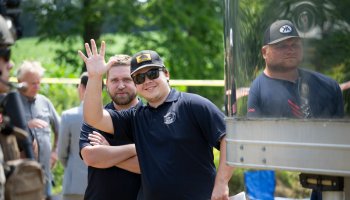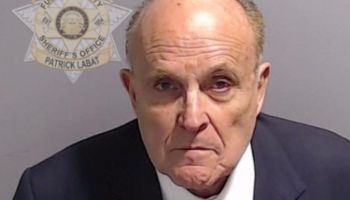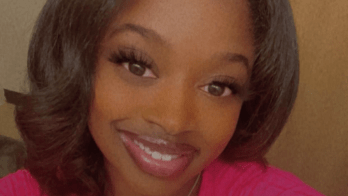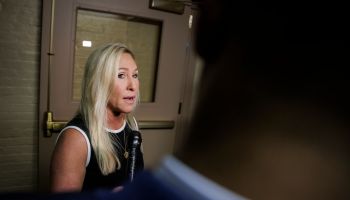During this women’s history month, we at NewsOne are honoring the remarkable accomplishments of 12 sheroes whom we love and who have demonstrated the noblest qualities of humanity:
1) Michelle Obama: She is the 44th First Lady, an attorney, Mother, and wife. Mrs. Obama has focused her attentions on the issues that face military families, the plight of homelessness, helping working women balance career and family, encouraging national service, promoting the arts and education, and fostering healthy eating and literacy among our youth. As a Mother to two young girls, Sasha and Malia, the First Lady has led a staunch campaign against childhood obesity, an effort which she wants to leave as her legacy. Mrs. Obama’s “Let’s Move!” campaign challenges the problem of childhood obesity, so that today’s youth can reach adulthood at a healthy weight and possibly avoid all of the chronic ailments that plague those who are overweight.
2) Dr. Mae Jemison: Dr. Jemison was working as a general practitioner in Los Angeles, Calif., when NASA selected her and 14 others for astronaut training. Dr. Jemison completed her training as a mission specialist with NASA in 1988. In September of 1992, as a mission specialist aboard the Shuttle Endeavour, Jemison became the first African-American female astronaut and the first Black woman to orbit the earth. In 1993, Dr. Jemison resigned from NASA and founded the Jemison Group Inc., which focuses on the integration of science and technology in to daily life. Among her current projects are several that focus on improving health care in Africa and advancing technology in developing countries. She also created The Earth We Share, a science camp for 12 to 16-year-olds that helps improve students’ problem-solving skills.
3) Ruby Dee: An actress whose career has spanned more than 50 years, Dee, who has also worn the hats of writer and activist, is the sheer epitome of a phenomenal woman. Miss Dee and her late-husband, actor Ossie Davis, collaborated on several projects that promoted Black heritage, which was evident in their 1981 series “With Ossie and Ruby” for PBS. In civil rights matters, Miss Dee was front and center at countless demonstrations, lending her full-fledged support to demonstrations like the Dr. Martin Luther King Jr.’s 1963 March on Washington. Dee has also been a member of the Congress of Racial Equality, the NAACP, the Student Nonviolent Coordinating Committee, Delta Sigma Theta sorority, and the Southern Christian Leadership Conference. Dee and Davis were personal friends of both Dr. King and Malcolm X, with Davis giving the eulogy at Malcolm’s funeral in 1965. In 1999, Dee and Davis were arrested for protesting the fatal shooting of unarmed West African immigrant Amadou Diallo by White police officers of the New York City Police Department. Miss Dee has been the recipient of countless awards and accolades, and at 90 years young, she is still unstoppable.
4) Dr. Patricia Bath: A true ground breaker, Dr. Bath, an ophthalmologic surgeon, inventor, and activist for patients’ rights, has dedicated her life for the right to sight. Cataracts affect African Americans at higher rates than Caucasians, and Dr. Bath’s invention of the Laserphaco Probe in 1986 increased the accuracy and results of cataract surgery, which had previously been performed manually with the more riskier and harsher mechanical grinder. Dr. Bath became the first African-American female doctor to receive a patent for a medical purpose. In the late sixties as an intern at Harlem Hospital in New York City, Dr. Bath conducted a study documenting her observation that blindness among Blacks was nearly double the rate of blindness among Whites. She concluded that this was largely due to many African-Americans’ lack of access to ophthalmic care. With this finding, Bath established a new discipline known as Community Ophthalmology that is now studied and practiced worldwide. She also helped bring eye surgery services to Harlem Hospital’s Eye Clinic, which has since helped to treat and cure thousands of patients. In 1975, Bath became the first African-American woman surgeon at the UCLA Medical Center, and eight years later, Dr. Bath was named chair of the Ophthalmology Residency Training Program that she also co-founded, at Drew/UCLA. She was the first woman in the country to hold such a position. In 1976, she co-founded the American Institute for the Prevention of Blindness, an organization that aims to “protect, preserve, and restore the gift of sight” for all persons, regardless of race, gender, age, or income level. Dr. Bath holds four patents for her invention, which is also utilized overseas. Although now retired, Dr. Bath, now 70, continues to devote her time to her lifelong cause, the prevention, treatment, and cure of blindness.
5) Areva Martin: A developmental disabilities advocate superhero who has come to the rescue of countless families seeking advocacy training and resources for their special needs children, Areva Martin has been a source of salvation. A Harvard law school graduate and co-founder of one of the premier Black-owned law firms in Los Angeles, Martin has made immeasurable strides in the quality of diagnosis and treatment options available to the families of thousands of special needs children in her South Los Angeles community. As a Mother with a child who has autism, her son’s diagnosis has only encouraged Martin to help empower people who have been dealt a hand that has left them powerless. An author, lecturer, and broadcasting legal analyst, Martin has been working to create a top-notch center in L.A. for special needs children that will provide parents with even greater access to diagnosis and treatment plans for their children.
6) Ellen Johnson Sirleaf: As the 24th President of Liberia and the first elected female Head of State in Africa, Sirleaf has worked hard at good governance while advocating for the rights of women and the importance of education to provide a better future for her country and its people. Born on October 29, 1938, Sirleaf entered politics in 1972 by not holding her tongue, criticizing the then-regime, and speaking truth to power. After fighting for freedom, justice, and equality in Liberia in all of the high-level government and business posts for over four decades, in 1997, she contested the Presidential elections and was exiled to the Ivory Coast but kept monitoring the political situation in her native land. In 2005, Sirleaf successfully contested the 2005 presidential elections, resulting in her historic inauguration on January 16, 2006, as President of Liberia. During her time in office, Sirleaf has spent more than four years rebuilding post-conflict Liberia. The Mother of four sons and 11 grandchildren has revived national hope by strengthening the institutions of national security, leading the revitalization of the national economy and infrastructure, including the construction of more than 800 miles of roads and restoring Liberia’s international reputation and credibility. In 2010, Newsweek magazine listed Sirleaf as one of the 10 best leaders in the world, with Time placing her among the top-10 female leaders and the Economist calling her “the best President the country has ever had.”
7) Yuri Kochiyama: The name Kochiyama is not a variation of some African moniker, it is Japanese and belongs to a woman who has fought for the rights of minorities for some 50 years. And even though she is not Black, countless would say she is a card-carrying member of the race due to her efforts. Born in 1921, Kochiyama moved to a low-income projects apartment in Harlem, New York, with her husband, Bill, in 1960 and soon joined the Harlem Parents Committee, a grassroots organization fighting for safer streets and integrated education. She quickly became immersed in the politics of the Black liberation movement and joined the crusade of Malcolm X, forging a friendship. Kochiyama became a devotee of the electrifying Brother X and signed up to become a member of his Organization of Afro-American Unity, which he formed after he broke ties with the Nation of Islam. As a matter of fact, when Malcolm X lay dying from his assassination, Kochiyama was the one who cradled him in her arms. Kochiyama also became involved with the Freedom Riders, the ’60s civil rights activists who rode buses in to segregated southern towns to protest local laws and customs that enforced interstate travel segregation. In 1977, when Puerto Ricans took over the Statue of Liberty to voice their demands for independence from the United States and the release of five jailed activists, Kochiyama locked arms with the protestors. In 2005, Kochiyama was nominated for the Nobel Peace Prize for her unrelenting struggles against racism.
8) Cathy Hughes: A radio maven, entrepreneur and a force to be reckoned with Hughes went from being a stereotypical statistic, a young black unmarried teen mom, to becoming a major boardroom player. She now stands front and center as CEO and president at the forefront of corporate America, as she runs two of the largest minority-owned broadcasting companies in the U.S., Radio One, which owns NewsOne, and TV One. Hughes, who grew up poor in an Omaha, Nebraska, housing project knew she wanted to be in broadcasting by the time she was 8 years old. She has had plenty of obstacles on the way to the top but met her challenges head on. Hughes managed to raise her son and receive a college education although she never had the opportunity to graduate. The 64-year-old managed to land her first radio gig in 1969 as a volunteer at an all-Black Omaha radio station. A mere six years later, Hughes served as a station manager to the Howard University radio station in Washington D.C. In 1978, Hughes took a job as the general manager of WYCB-AM in Washington, D.C., the move established her as the first African-American to hold such a position in the Washington, D.C., media market. Hughes continued to soar purchasing radio stations across the country until she put Radio One on the map. The company currently has a network of 69 radio stations, located in 22 American cities, with 13 million listeners. In 2004, Hughes launched TV One, a cable television channel that targeted at African-Americans. Hughes has used the power of her broadcasting medium to empower blacks, to infuse her community with positive images and vital information that is pertinent to their very existence and she has done so with a thoroughness and integrity.
9) Rev. Alveda King: Deemed the “voice of the voiceless” and an enemy of pro-choice advocates everywhere, King, the niece of civil rights activist Dr. Martin Luther King Jr. believes that unborn babies have a right to life. Alveda said her mother wanted to abort her so she could continue college but her grandfather was able to convince her to keep her child. Alveda, a pro-life activist and evangelical minister, is driven by a strong spiritual conviction to keep the controversial issue of abortion before lawmakers. The Mother of six, who once had an involuntary and voluntary abortion herself, is fighting to keep women from undergoing what she feels is the extremely painful and emotional detriment that she underwent after losing her unborn children. Once a staunch Democrat who even held office as a Congresswoman in Georgia’s 28th district from 1979 to 1981, the now very conservative and fundamentalist King is currently also campaigning for women everywhere to go to their pastors and speak out for the rights of the unborn. King firmly believes that the abortion industry specifically seems to target and harm the Black community, saying that with Planned Parenthood as the largest abortion provider in America, 78 percent of their clinics are in minority communities. Blacks make up 12 percent of the population, but make up 35 percent of the abortions in America. “Are we being targeted? Isn’t that genocide?” King, 62, claims that we are the only minority in America that is on the decline in population and is crusading to offer women alternatives to abortion.
10) Thelma Golden: In a White male-dominated profession, Golden broke the barriers by becoming one of the world’s most revered curators. As director and chief curator of the Studio Museum in New York City’s Harlem, Golden has been a staunch supporter and a true driving force in the arts world. Golden spent 10 years at one of the world’s most-premier art museums the Whitney Museum of American Art in New York City, and there, she tried to get the public to look beyond stereotypes and to open up the mainstream museum to African American and other previously under-represented artists and art-lovers. Golden then made the decision to join the famed Studio Museum in the year 2000, and within five years, she was at the helm of the world-renowned institution. Golden came in like gangbusters with a plan to showcase forward-facing art from throughout the African Diaspora. The Queens, New York, native, who at age 12 knew that someday she would be a curator, also serves on numerous international art prize committees and is a juror for nearly all of the public art commissioned in New York City. She also travels the globe in search of new Black artists to champion.
11)Diane Nash: A leader and strategist bar-none, Nash is one of those unsung heroes of the turbulent Civil Rights Era. The woman who has been described as fearless with an unerring instinct for orchestrating some of the most powerfully successful civil rights protests, Nash was one of the brains behind the famed lunch counter desegregation protests and was pivotal in the formation of the Freedom Riders who desegregated interstate travel, was a founder of the Student Nonviolent Coordinating Committee, and was instrumental in organizing the 1965 Selma Voting Rights Movement, an initiative of marches that resulted in the Voting Rights Act of 1965, guaranteeing voting rights to citizens regardless of race. The now-74-year-old woman, who played a major role in gaining equality for Blacks has continued to work for the impoverished and homeless throughout the years.
12) Ursula Burns: Forbes named her the “14th Most Powerful Woman In The World” and as the first African-American woman CEO to head a Fortune 500 company, Burns dreamed big and turned it into a reality. Raised by a single Mom in a New York City low-income housing project, Burns’ parents, who were Panamanian immigrants, made sure to emphasize education. Consequently, Burns obtained her Master of Science degree in mechanical engineering from the prestigious Columbia University in 1981 and began working at Xerox as a summer intern in 1980. She was then hired in 1981 after she received her master’s degree. Throughout the ensuing years, Burns worked in several departments within the mega-corporation. In 1990, Burns became an executive assistant for the company’s senior executive, and even though Burns thought that the job move would certainly put a kibosh on her career plans, she humbled herself and accepted the administrative role. The position turned out to be a blessing in disguise. A year later, Burns became the executive assistant to Xerox’s chairman and chief executive and eight years later she was named vice president for global manufacturing. In 2000, Burns became a senior vice president and worked closely with the company’s female CEO, Anne Mulcahy. The two women forged a successful partnership, and in 2009, when Mulcahy left the corporation, Burns took over the role of CEO. The 54-year-old married working Mom of two has proven that no task is too small when you have your eyes on the prize.















